PONTIAC GRAND PRIX 2004 Owners Manual
Manufacturer: PONTIAC, Model Year: 2004, Model line: GRAND PRIX, Model: PONTIAC GRAND PRIX 2004Pages: 432, PDF Size: 2.99 MB
Page 341 of 432
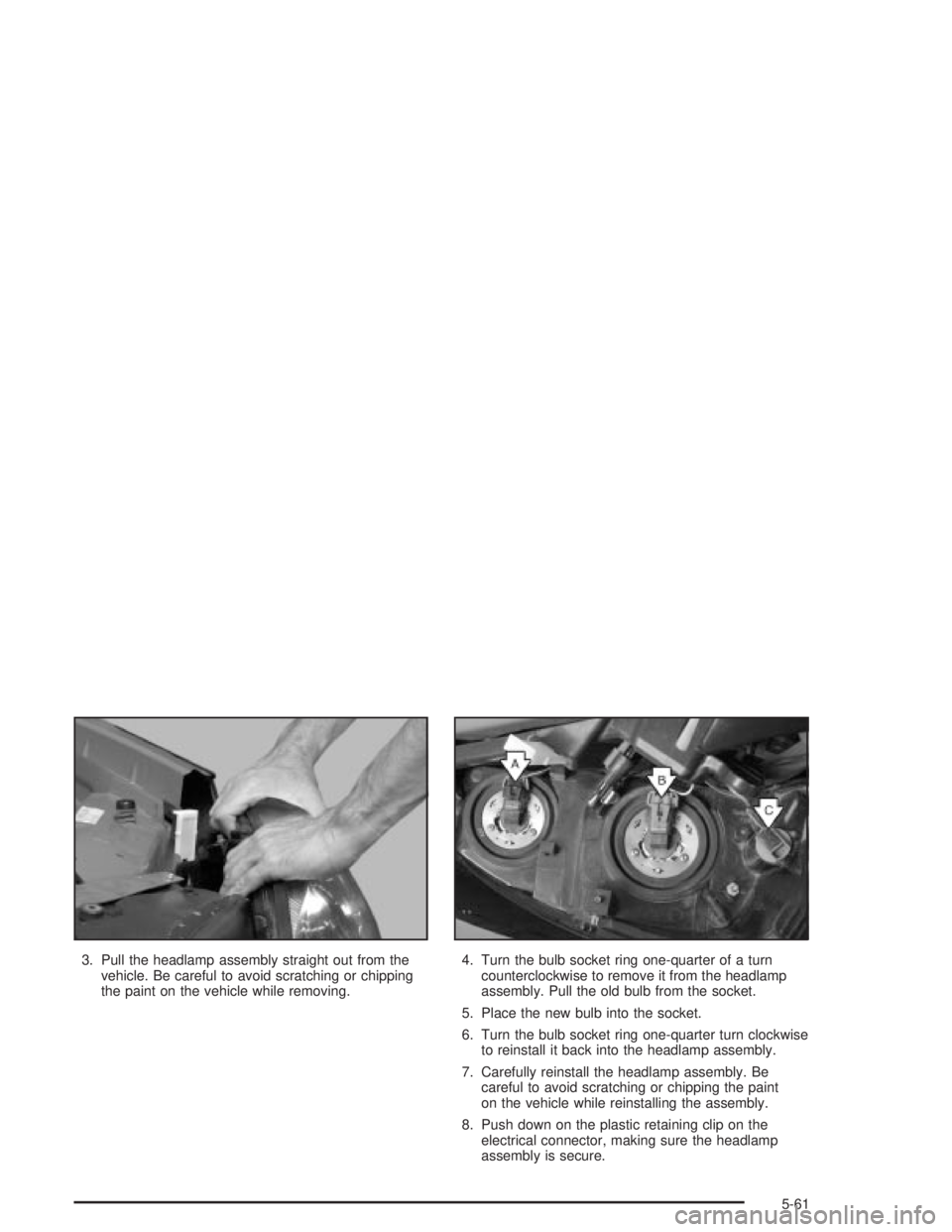
3. Pull the headlamp assembly straight out from the
vehicle. Be careful to avoid scratching or chipping
the paint on the vehicle while removing.4. Turn the bulb socket ring one-quarter of a turn
counterclockwise to remove it from the headlamp
assembly. Pull the old bulb from the socket.
5. Place the new bulb into the socket.
6. Turn the bulb socket ring one-quarter turn clockwise
to reinstall it back into the headlamp assembly.
7. Carefully reinstall the headlamp assembly. Be
careful to avoid scratching or chipping the paint
on the vehicle while reinstalling the assembly.
8. Push down on the plastic retaining clip on the
electrical connector, making sure the headlamp
assembly is secure.
5-61
Page 342 of 432
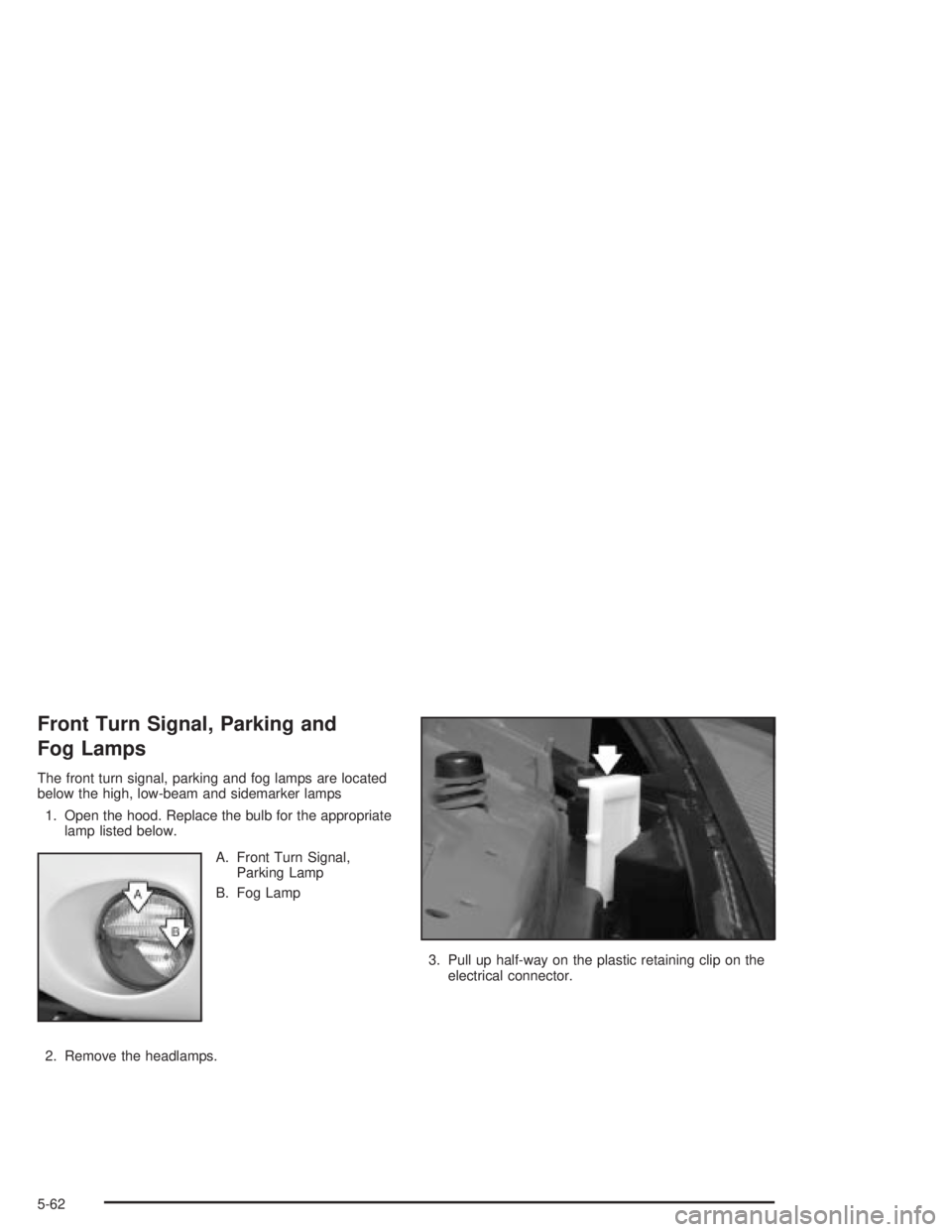
Front Turn Signal, Parking and
Fog Lamps
The front turn signal, parking and fog lamps are located
below the high, low-beam and sidemarker lamps
1. Open the hood. Replace the bulb for the appropriate
lamp listed below.
A. Front Turn Signal,
Parking Lamp
B. Fog Lamp
2. Remove the headlamps.3. Pull up half-way on the plastic retaining clip on the
electrical connector.
5-62
Page 343 of 432
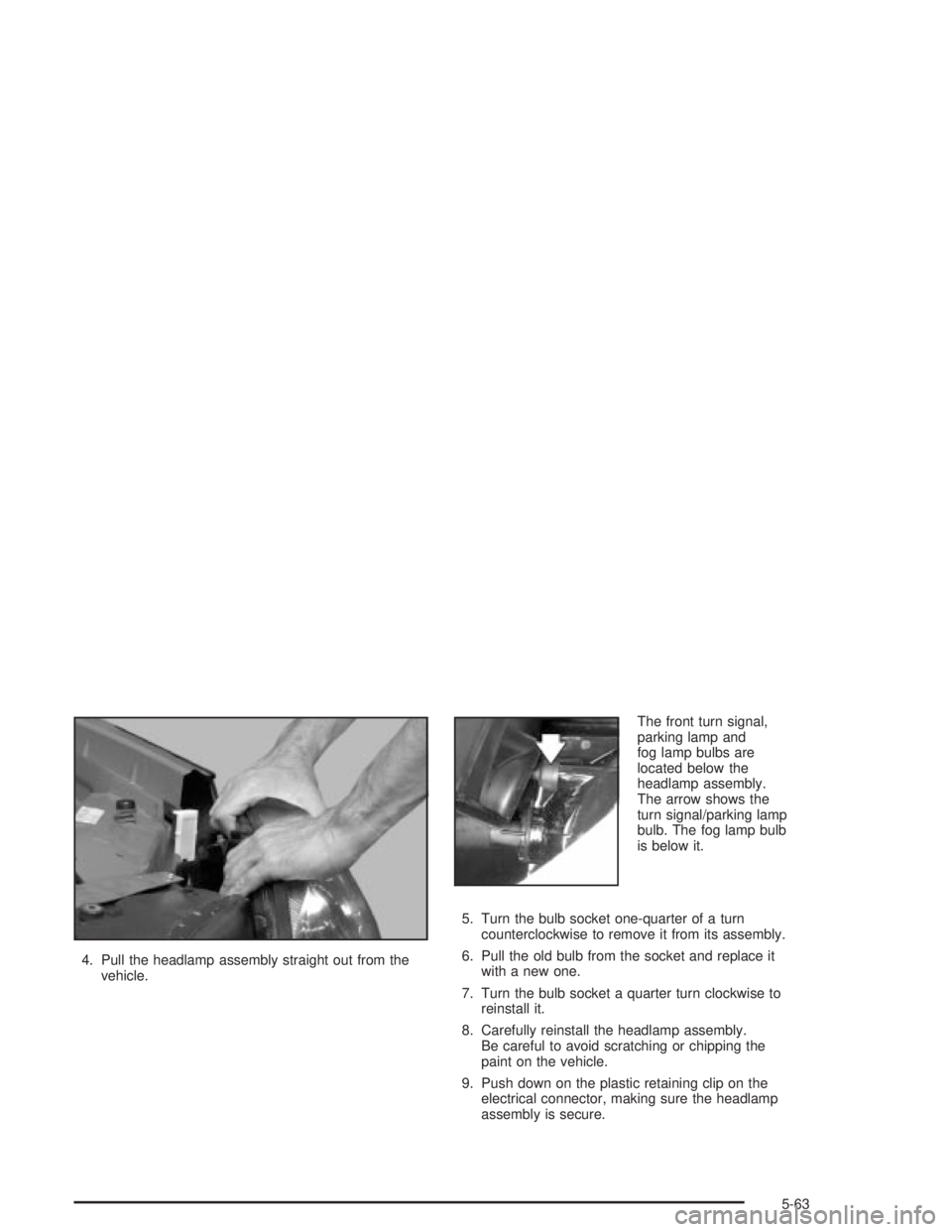
4. Pull the headlamp assembly straight out from the
vehicle.The front turn signal,
parking lamp and
fog lamp bulbs are
located below the
headlamp assembly.
The arrow shows the
turn signal/parking lamp
bulb. The fog lamp bulb
is below it.
5. Turn the bulb socket one-quarter of a turn
counterclockwise to remove it from its assembly.
6. Pull the old bulb from the socket and replace it
with a new one.
7. Turn the bulb socket a quarter turn clockwise to
reinstall it.
8. Carefully reinstall the headlamp assembly.
Be careful to avoid scratching or chipping the
paint on the vehicle.
9. Push down on the plastic retaining clip on the
electrical connector, making sure the headlamp
assembly is secure.
5-63
Page 344 of 432
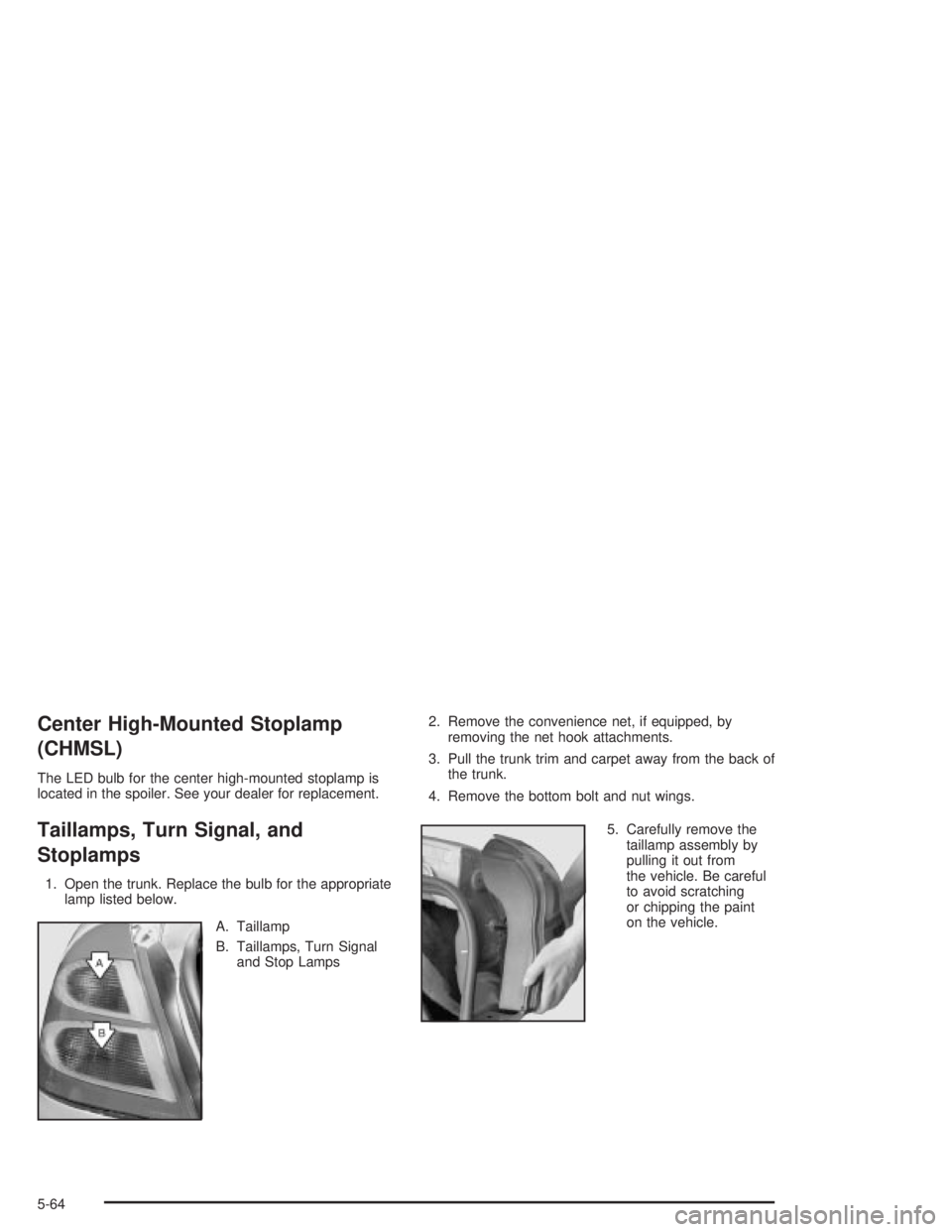
Center High-Mounted Stoplamp
(CHMSL)
The LED bulb for the center high-mounted stoplamp is
located in the spoiler. See your dealer for replacement.
Taillamps, Turn Signal, and
Stoplamps
1. Open the trunk. Replace the bulb for the appropriate
lamp listed below.
A. Taillamp
B. Taillamps, Turn Signal
and Stop Lamps2. Remove the convenience net, if equipped, by
removing the net hook attachments.
3. Pull the trunk trim and carpet away from the back of
the trunk.
4. Remove the bottom bolt and nut wings.
5. Carefully remove the
taillamp assembly by
pulling it out from
the vehicle. Be careful
to avoid scratching
or chipping the paint
on the vehicle.
5-64
Page 345 of 432
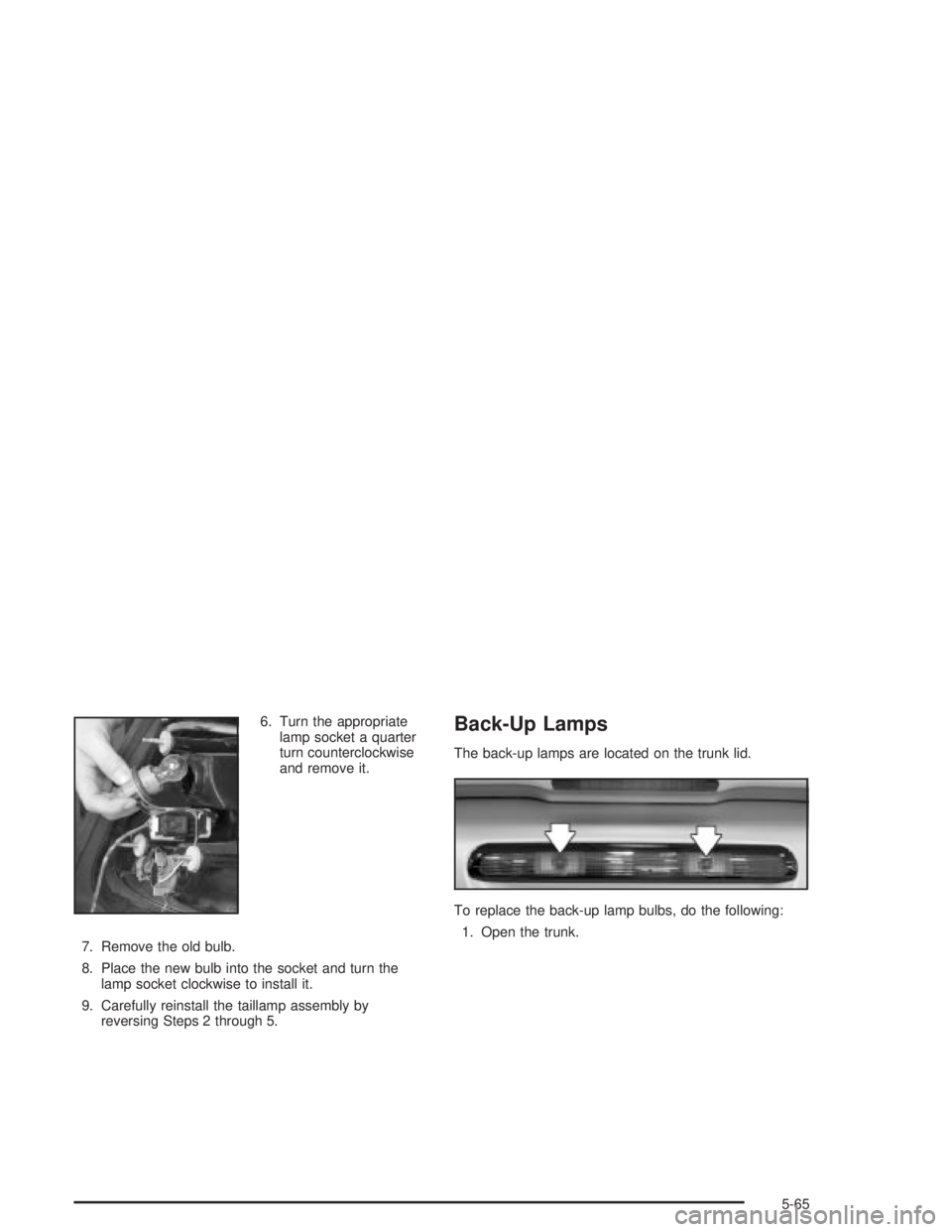
6. Turn the appropriate
lamp socket a quarter
turn counterclockwise
and remove it.
7. Remove the old bulb.
8. Place the new bulb into the socket and turn the
lamp socket clockwise to install it.
9. Carefully reinstall the taillamp assembly by
reversing Steps 2 through 5.Back-Up Lamps
The back-up lamps are located on the trunk lid.
To replace the back-up lamp bulbs, do the following:
1. Open the trunk.
5-65
Page 346 of 432
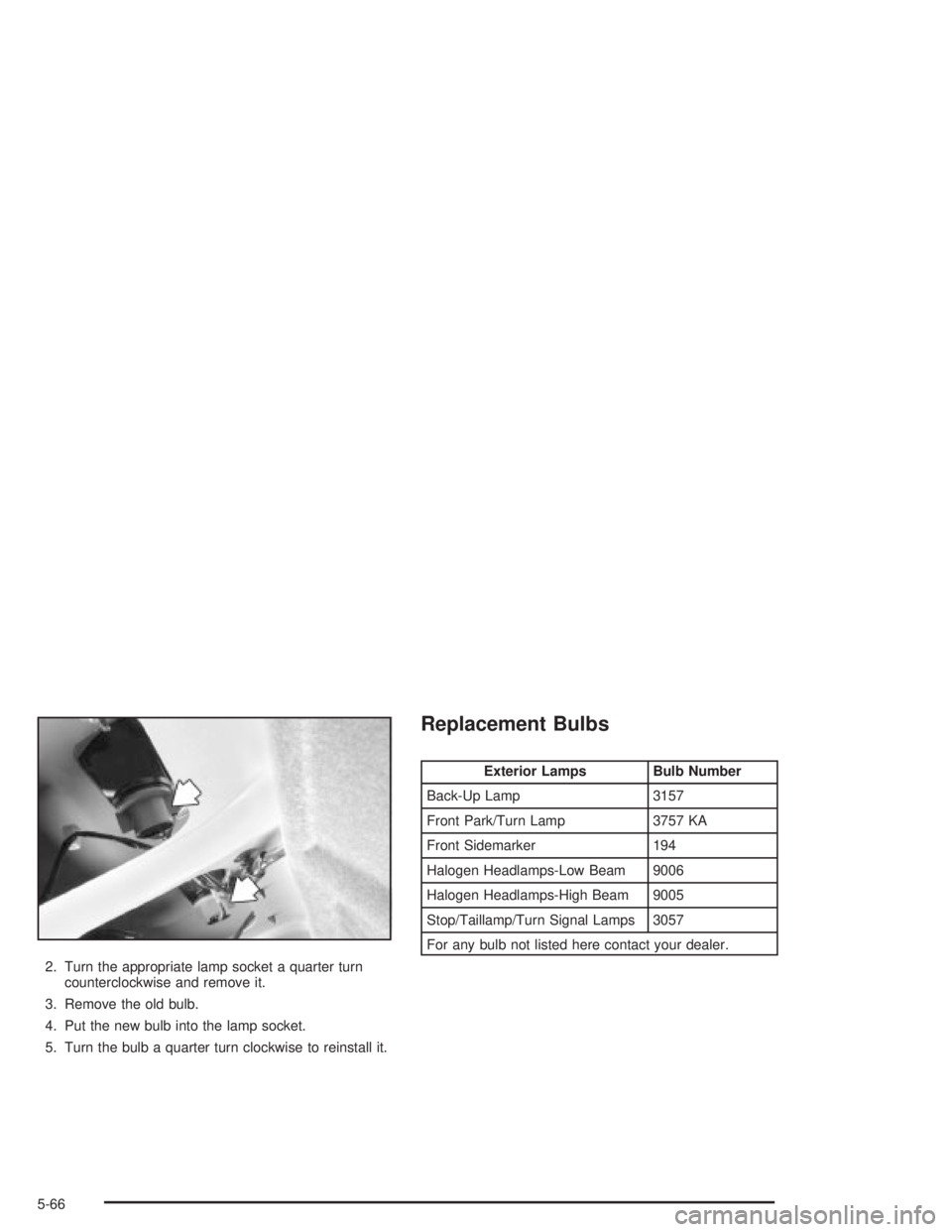
2. Turn the appropriate lamp socket a quarter turn
counterclockwise and remove it.
3. Remove the old bulb.
4. Put the new bulb into the lamp socket.
5. Turn the bulb a quarter turn clockwise to reinstall it.
Replacement Bulbs
Exterior Lamps Bulb Number
Back-Up Lamp 3157
Front Park/Turn Lamp 3757 KA
Front Sidemarker 194
Halogen Headlamps-Low Beam 9006
Halogen Headlamps-High Beam 9005
Stop/Taillamp/Turn Signal Lamps 3057
For any bulb not listed here contact your dealer.
5-66
Page 347 of 432
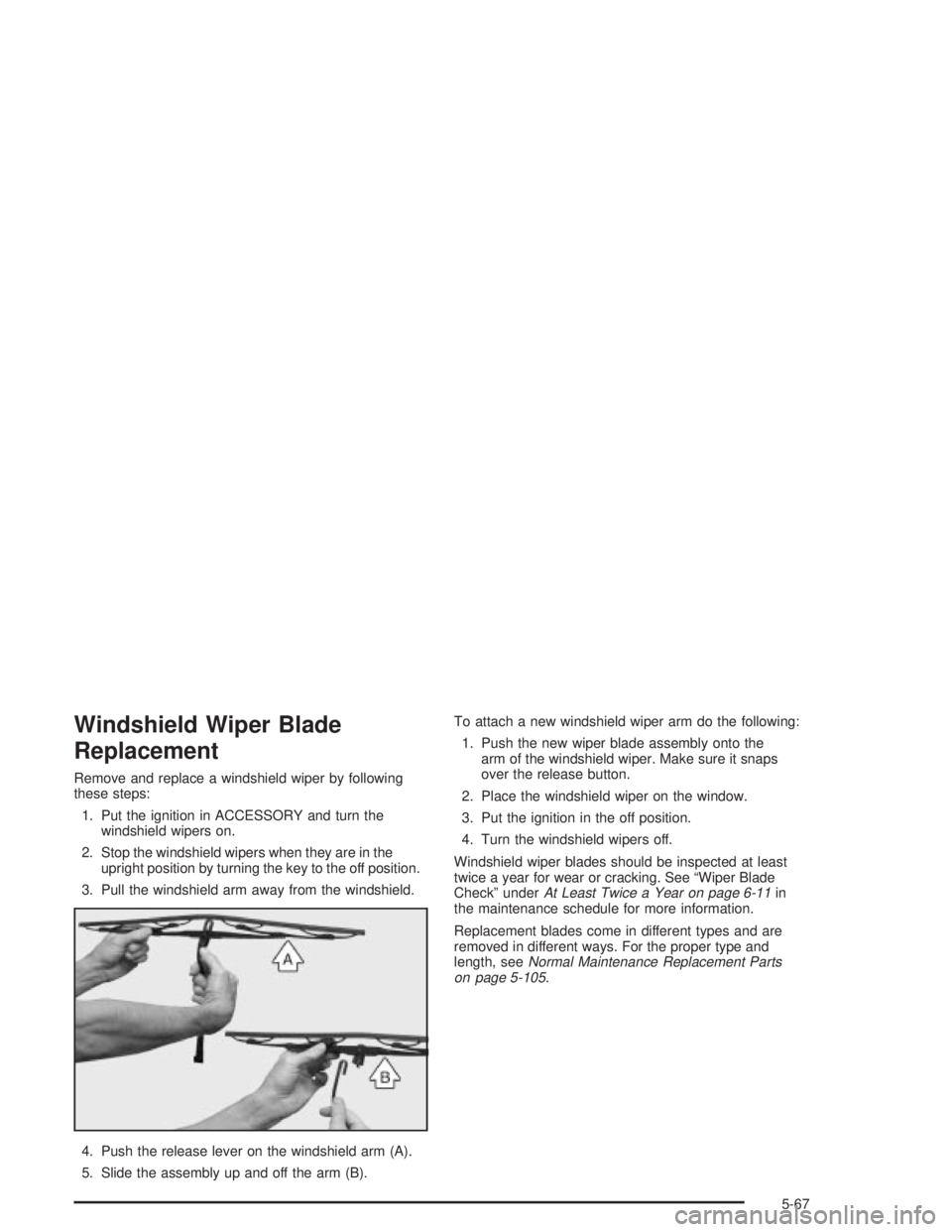
Windshield Wiper Blade
Replacement
Remove and replace a windshield wiper by following
these steps:
1. Put the ignition in ACCESSORY and turn the
windshield wipers on.
2. Stop the windshield wipers when they are in the
upright position by turning the key to the off position.
3. Pull the windshield arm away from the windshield.
4. Push the release lever on the windshield arm (A).
5. Slide the assembly up and off the arm (B).To attach a new windshield wiper arm do the following:
1. Push the new wiper blade assembly onto the
arm of the windshield wiper. Make sure it snaps
over the release button.
2. Place the windshield wiper on the window.
3. Put the ignition in the off position.
4. Turn the windshield wipers off.
Windshield wiper blades should be inspected at least
twice a year for wear or cracking. See ªWiper Blade
Checkº under
At Least Twice a Year on page 6-11in
the maintenance schedule for more information.
Replacement blades come in different types and are
removed in different ways. For the proper type and
length, see
Normal Maintenance Replacement Parts
on page 5-105.
5-67
Page 348 of 432
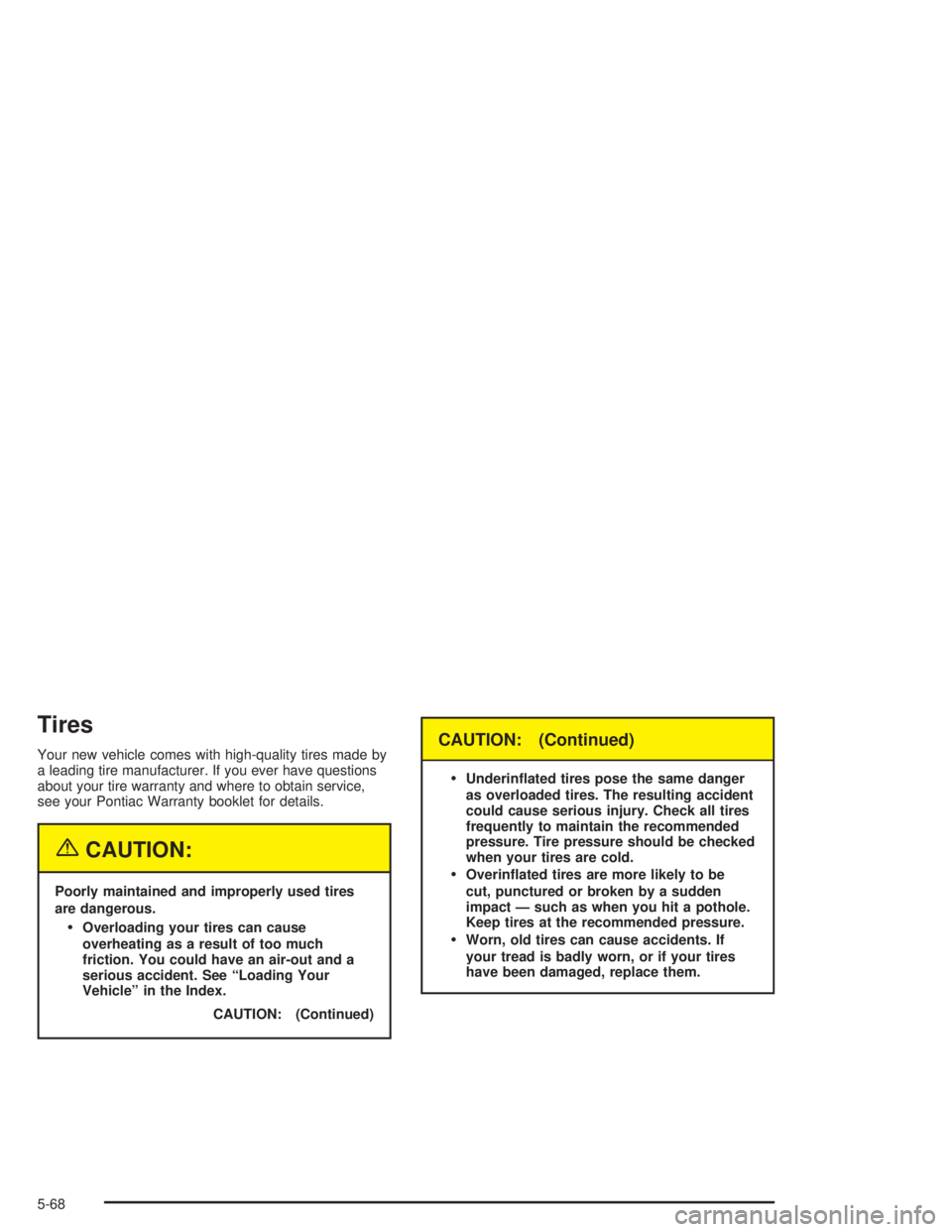
Tires
Your new vehicle comes with high-quality tires made by
a leading tire manufacturer. If you ever have questions
about your tire warranty and where to obtain service,
see your Pontiac Warranty booklet for details.
{CAUTION:
Poorly maintained and improperly used tires
are dangerous.
·Overloading your tires can cause
overheating as a result of too much
friction. You could have an air-out and a
serious accident. See ªLoading Your
Vehicleº in the Index.
CAUTION: (Continued)
CAUTION: (Continued)
·
Underin¯ated tires pose the same danger
as overloaded tires. The resulting accident
could cause serious injury. Check all tires
frequently to maintain the recommended
pressure. Tire pressure should be checked
when your tires are cold.
·Overin¯ated tires are more likely to be
cut, punctured or broken by a sudden
impact Ð such as when you hit a pothole.
Keep tires at the recommended pressure.
·Worn, old tires can cause accidents. If
your tread is badly worn, or if your tires
have been damaged, replace them.
5-68
Page 349 of 432
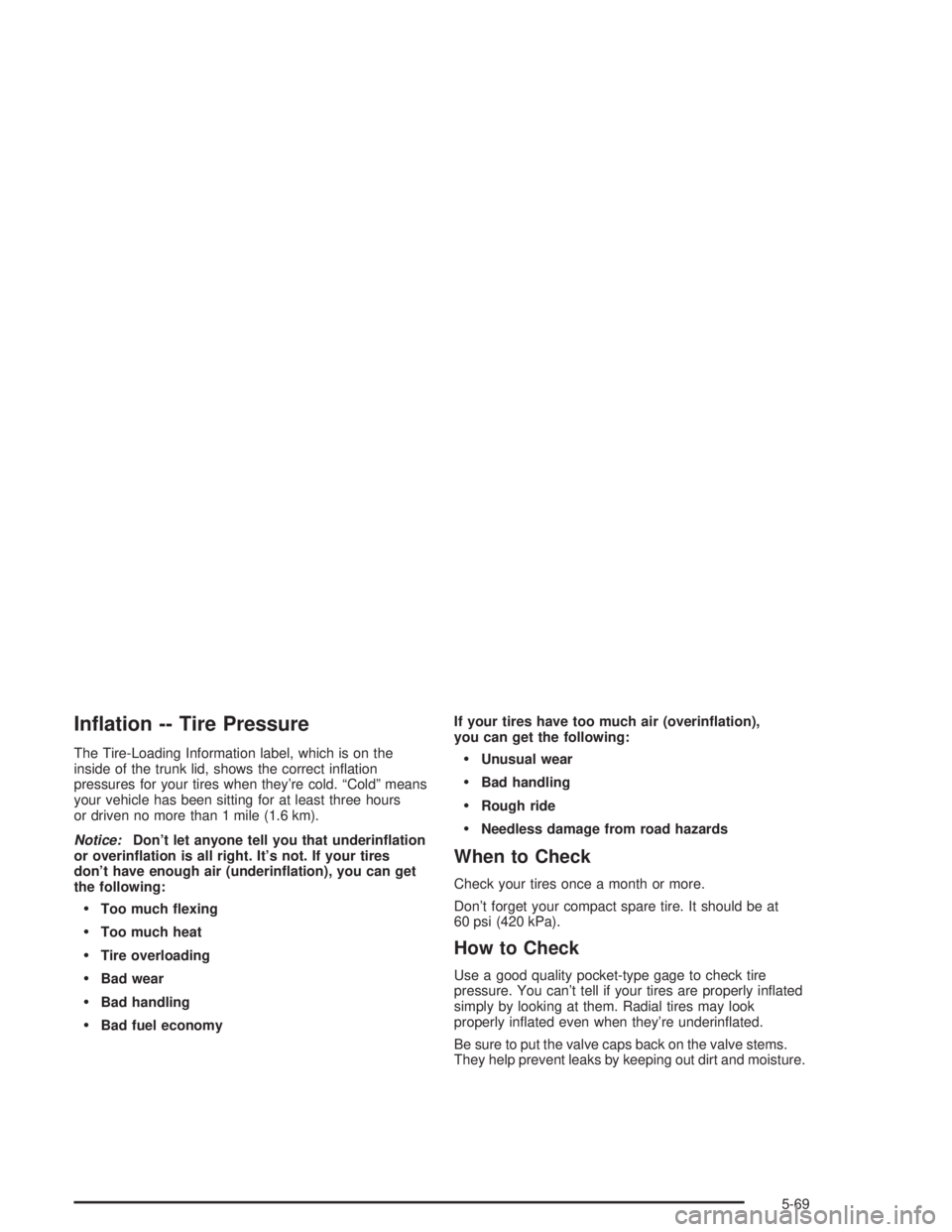
In¯ation -- Tire Pressure
The Tire-Loading Information label, which is on the
inside of the trunk lid, shows the correct in¯ation
pressures for your tires when they're cold. ªColdº means
your vehicle has been sitting for at least three hours
or driven no more than 1 mile (1.6 km).
Notice:Don't let anyone tell you that underin¯ation
or overin¯ation is all right. It's not. If your tires
don't have enough air (underin¯ation), you can get
the following:
·Too much ¯exing
·Too much heat
·Tire overloading
·Bad wear
·Bad handling
·Bad fuel economyIf your tires have too much air (overin¯ation),
you can get the following:
·Unusual wear
·Bad handling
·Rough ride
·Needless damage from road hazards
When to Check
Check your tires once a month or more.
Don't forget your compact spare tire. It should be at
60 psi (420 kPa).
How to Check
Use a good quality pocket-type gage to check tire
pressure. You can't tell if your tires are properly in¯ated
simply by looking at them. Radial tires may look
properly in¯ated even when they're underin¯ated.
Be sure to put the valve caps back on the valve stems.
They help prevent leaks by keeping out dirt and moisture.
5-69
Page 350 of 432

Tire Pressure Monitor System
This vehicle has the tire in¯ation monitor system, it can
alert you to a large change in the pressure of one
tire. The system ªlearnsº the pressure at each tire
throughout the operating speed range of your vehicle.
The system normally takes between 45 and 90 minutes
of driving to learn the tire pressures. This time may
be longer depending on your individual driving habits.
Learning need not be accumulated during a single
trip. Once learned, the system will remember the tire
pressures until the system is recalibrated.
See
DIC Warnings and Messages on page 3-65for
more information.
This symbol, along with the
CHECK TIRE PRESSURE
warning message will
appear in the Driver
Information Center (DIC)
if the pressure in one tire
becomes 12 psi (83 kPa)
lower than the other
three tires.
The tire in¯ation monitor system won't alert you if the
pressure in more than one tire is low, if the system is not
properly calibrated, or if the vehicle is moving faster
than 70 mph (110 km/h).The tire in¯ation monitor system detects differences in
tire rotation speeds that are caused by changes in tire
pressure. The system can alert you about a low tire ± but
it doesn't replace normal tire maintenance. See
Tires on
page 5-68.
When the CHECK TIRE PRESSURE warning message
comes on, you should stop as soon as you can and
check all your tires for damage. (If a tire is ¯at, see
If a Tire Goes Flat on page 5-78). Also, check the
tire pressure in all four tires as soon as you can.
See
In¯ation -- Tire Pressure on page 5-69.
The CHECK TIRE PRESSURE warning message will
also be displayed (while the ignition is on) until you reset
(calibrate) the system. To reset the system, see ªTire
In¯ation Monitor Systemº under the options mode in
DIC
Controls and Displays on page 3-45.
Don't reset the tire in¯ation monitor system without ®rst
correcting the cause of the problem and checking
and adjusting the pressure in all four tires. If you reset
the system when the tire pressures are incorrect,
the system will not work properly and may not alert you
when a tire is low.
Any time you adjust a tire's pressure, rotate your tires,
or have one or more tires repaired or replaced, you'll
need to reset (calibrate) the tire in¯ation monitor system.
You'll also need to reset the system whenever you
buy new tires and whenever the vehicle's battery has
been disconnected.
5-70